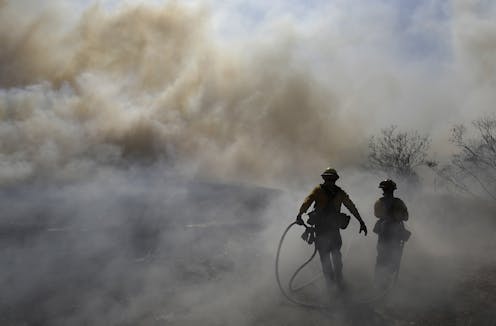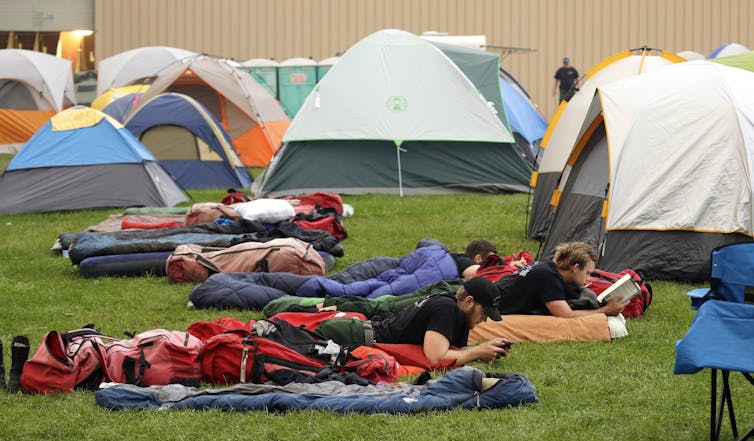Wildfire smoke worsens coronavirus risk, putting firefighters in extra danger
Wildfire smoke makes it harder for firefighters' bodies to fight off viral invaders. But firefighting conditions make the usual protective measures nearly impossible.

As summer approaches, two forces of nature are on a collision course, and wildland firefighters will be caught in the middle.
New research suggests that the smoke firefighters breathe on the front lines of wildfires is putting them at greater risk from the new coronavirus, with potentially lethal effects.
At the same time, firefighting conditions make precautions such as social distancing and hand-washing difficult, increasing the chance that, once the virus enters a fire camp, it could quickly spread.
As an environmental toxicologist, I have spent the last decade expanding our understanding of how wood smoke exposure impacts human health. Much of my current research is focused on protecting the long-term health of wildland firefighters and the communities they serve.
‘Camp crud’ and the dangers of air pollution
People have long understood that the air they breathe can impact their health, dating back more than 2,000 years to Hippocrates in his treatise on Air, Water, and Places. Today, there is a growing consensus among researchers that air pollution, specifically the very fine particles called PM2.5, influences risk of respiratory illness. These particles are a tiny fraction of the width of a hair and can travel deep into the lungs.
Italian scientists reported in 2014 that air pollutants can increase the viral load in the lungs and reduce the ability of specialized cells called macrophages to clear out viral invaders.
Researchers in Montana later connected that effect to wood smoke. They found that animals exposed to wood smoke 24 hours before being exposed to a pathogen ended up with more pathogen in their lungs. The researchers showed that wood smoke exposure decreased the macrophages’ ability to combat respiratory infection.
Now, new evidence suggests that long-term exposure to PM2.5 air pollution, which is produced by sources such as wildfires, power plants and vehicles, may make coronavirus particularly deadly.
Researchers from the Harvard T.H. Chan School of Public Health conducted a nationwide study of county-level data and found that even a small increase in the amount of PM2.5 from one U.S. county to the next was associated with a large increase in the death rate from COVID-19. While small increases in PM2.5 also raise the risk of death from other causes for older adults, the magnitude of the increase for COVID-19 was about 20 times greater. The results were released last week, before the usual peer review process was conducted, to help warn people of the risks.

Taken together, these findings suggest that air pollution, including wood smoke, could increase the risk that wildland firefighters will develop severe COVID-19 symptoms.
That probably doesn’t surprise seasoned firefighters.
They’re already familiar with “camp crud,” a combined upper and lower respiratory illness accompanied by cough and fatigue that has become common in firefighting camps.
The National Wildfire Coordinating Group, in its guidance on infectious disease, has pointed out that “the close, overlapping living conditions of an incident command post lends itself to rapid spreading of contagious microorganisms, as witnessed by the common outbreaks of ‘camp crud.’ Outbreaks also have a history of spreading from incident to incident as people are reassigned.”
How to protect wildland firefighters
So, what can be done to avoid the spread of COVID-19 among wildland firefighters and prevent them from being vectors in the communities they serve?
In some areas, officials have been delaying firefighter training sessions and brush-clearing operations that would normally be underway now. But while that might protect firefighters from exposure right now, it can be put off for only so long. Wildfires have already broken out in several states, and delaying controlled burns leaves more fuel when fires get out of control.
The National Wildfire Coordinating Group’s guidance on infectious disease encourages planning ahead so personal protective equipment is available and maintaining records of symptoms so illnesses can be tracked and stopped from spreading.
The guidance also calls for better camp hygiene, providing access to medical care, making isolation possible and coordinating cross-agency communication about the public health risks.
Firefighter camps are not typically well outfitted to promote good personal hygiene. Improving those conditions could help prevent a virus’s spread, such as by adding hand-washing stations and possibly mobile shower units. Single-person tents would allow for more effective social distancing.
Camp personnel should also have access to thermometers and coronavirus test kits. Protocols for quarantining and removing infected firefighters from the field should not only be implemented but practiced.
Also missing from the National Wildfire Coordinating Group’s guidance are policies on traveling to and from training sites, working within communities and traveling from camp. Social distancing may not always be possible, so protective gear, such as face masks, should be made available and their use encouraged.
A recent paper from Belgium suggests that even some of the ways firefighters operate in the field should be reconsidered to protect against the virus’s spread. It shows how droplets released when a person exhales can travel farther than six feet during heavy activity. For firefighters, that could mean walking farther apart and in a V-shaped delta formation, rather than a traditional line, to reach the fire.
It is also important to consider that frontline firefighters are often younger and could be asymptomatic but still able to spread the virus, so their contact with with rural community members, such as volunteer firefighters and ranchers, should be considered.
Finally, a system for cross-state communication should be engaged to facilitate sharing of best practices and lessons learned. It also could help track the movement of firefighters across the region.
The safety of rural western communities depends on the wildland firefighters and their ability to respond to emergencies. Protecting their health helps protect public health, too.
[You need to understand the coronavirus pandemic, and we can help. Read The Conversation’s newsletter.]
Luke Montrose does not work for, consult, own shares in or receive funding from any company or organization that would benefit from this article, and has disclosed no relevant affiliations beyond their academic appointment.
Read These Next
Epstein’s victims deserve more attention than his ‘client list’
Powerful men connected to Jeffrey Epstein are named, dissected and speculated about. The survivors,…
Christmas trees are more expensive than ever in Colorado — what gives?
Most Christmas trees are imported from other states, which drives up costs.
How the NIH became the backbone of American medical research and a major driver of innovation and ec
The agency’s budget has grown steadily since the 1960s, fueling an industry that creates lifesaving…





